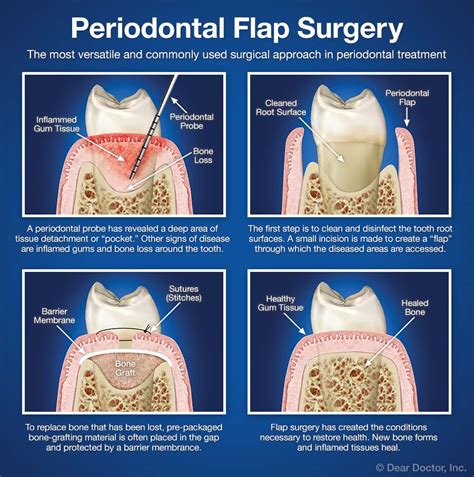Understanding Periodontal Treatment Coverage
Periodontal treatment is a dental procedure that is performed to treat gum diseases. It involves cleaning the teeth and gums thoroughly to prevent the progression of gum disease. Gum disease occurs when plaque and tartar stay on the gums, causing bacterial infection and inflammation. The resulting condition, called periodontitis, can cause tooth loss, pain, and discomfort. Periodontal treatment can be costly, which is why it is essential to understand if your insurance covers this dental service.
Understanding periodontal treatment coverage is crucial because the cost of periodontal treatment can vary depending on the type of treatment and the severity of the gum disease. Insurance companies may cover some dental procedures, but not all. It is also essential to know what periodontal treatment costs without insurance, so you can make an informed decision about getting periodontal treatment.
There are three types of periodontal treatment: periodontal maintenance, scaling and root planing, and periodontal surgery. Your insurance coverage for periodontal treatment may vary depending on the type of treatment needed.
The first type of periodontal treatment is periodontal maintenance, which is a cleaning procedure to prevent the progression of gum disease. This treatment is done twice a year, and insurance companies usually cover it with no additional out-of-pocket costs for patients. Insurance companies will typically pay 100% of the cost of periodontal maintenance. Patients who have dental insurance benefits that cover regular cleanings will usually have their periodontal maintenance covered as well.
Scaling and root planing is a more in-depth periodontal treatment, which involves cleaning the the teeth and gums more thoroughly. During this procedure, tartar and plaque are removed from the roots of the teeth. Insurance companies will typically cover this procedure, but the coverage for scaling and root planing could vary from one plan to another. Patients may be responsible for a copay or deductible depending on the provider or plan. Some insurance plans may require a waiting period before they cover scaling and root planing.
Periodontal surgery is the most expensive type of periodontal treatment because it involves surgery to the gums. It is usually the last resort when other treatments are not working, and the gum disease has advanced to a severe extent. Insurance companies usually cover periodontal surgery. Insurance providers may have different deductibles or patient co-pay fees, depending on the patient’s plan. Some plans may exclude the procedure entirely or limit the amount of coverage. Patients are advised to check with their insurance provider about the specifics of their individual plan to know how much coverage they can expect when it comes to periodontal surgery.
Understanding periodontal treatment coverage with insurance is essential to ensure that you get quality dental care without financial strain. Dental insurance is sometimes complex with numerous rules regarding coverage, waiting periods, and co-pays. It can be overwhelming to navigate through insurance policies. Still, the straightforward step is to consult with your insurance provider before starting any treatment and getting a cost estimate.
Patients are encouraged to shop and compare costs between dental offices to get better deals on periodontal treatment. Some offices may offer discounts when compared to others.
In conclusion, periodontal treatment can be costly, but understanding periodontal treatment coverage with insurance can help reduce the out-of-pocket costs for patients. If you have gum disease, make sure you talk to your dental care provider and speak with your insurance company on what periodontal treatments are and aren’t covered by your plan.
Types of Insurance Plans That Cover Periodontal Treatment
Having a dental insurance plan can help reduce the cost of periodontal treatments significantly. There are different types of dental insurance plans that provide coverage for periodontal treatment, including:
Preferred Provider Organization (PPO) Plans
PPO plans are one of the most common types of dental insurance plans. With these plans, the insurance company has a list of approved dentists or dental providers who have agreed to a contracted fee schedule. If you visit a dentist who is not in the list, you may have to pay higher out-of-pocket expenses. PPO plans usually cover a percentage of periodontal treatment costs, which can range from 50 to 80 percent, depending on the plan and the treatment needed. Some PPO plans have annual deductibles or maximum benefits.
Health Maintenance Organization (HMO) Plans
HMO plans are another type of dental insurance plan that usually requires a primary care dentist to be selected. With HMO plans, there are typically no deductibles or annual maximums, but the options for dentists may be more limited. They often cover preventative care like cleanings at no cost and may offer discounted rates for other treatments, including periodontal treatment.
Point of Service (POS) Plans
POS plans are similar to PPO plans, but they typically require a referral from your primary dentist to see a specialist like a periodontist. They often provide more coverage for in-network dentists or dental providers and may partially cover out-of-network providers. The percentage of coverage for periodontal treatment can vary between 50 to 80 percent, and annual deductibles or maximum benefits may also apply.
Indemnity Insurance Plans
Indemnity insurance plans are the most open-ended dental insurance plans. They allow you to see any dentist or dental provider you prefer without referral or penalty. These plans often come with higher out-of-pocket costs, but if you need periodontal treatment, you can receive partial or full coverage depending on the plan’s policies.
Coverage Limitations and Requirements
It is essential to note that even with dental insurance coverage, there may be limitations and requirements that can affect how much is covered for your periodontal treatment. For example, pre-existing conditions may limit coverage, and some plans may require a waiting period before covering certain treatments. Other plans may only cover periodontal treatment if the condition or disease has advanced beyond a certain point. It is always best to read your policy’s fine print and speak with your dental insurance provider about any questions or doubts regarding coverage.
Out-of-Pocket Costs for Patients
Even with insurance coverage, patients may still have to pay out-of-pocket costs, such as deductibles, copays, coinsurance, and fees for non-covered treatments. The amount can vary widely based on the type of insurance plan and the specific periodontal treatment needed. It is crucial to speak with your periodontist and determine the total cost of treatment before committing to any services so that you can plan and budget accordingly.
In conclusion, dental insurance plans can help alleviate some of the financial burden associated with periodontal treatments. The type of insurance plan and the specific policy’s details regarding periodontal treatment coverage can make a significant difference in your out-of-pocket expenses. Always remember to check with your dental insurance provider and periodontist about any limitations or requirements for periodontal treatment before committing to any services.
Factors That Affect Periodontal Treatment Cost with Insurance

Periodontal treatment is a crucial aspect of oral health, and having insurance can help cover some of the costs associated with the treatment. However, there are factors that can affect the overall cost you can expect to pay even with insurance. Knowing these factors can help you understand why costs can vary and make more informed decisions about your treatment options.
Degree of periodontitis
The degree of periodontitis you have is one of the main factors that can affect the cost of your treatment with insurance. If you have mild to moderate periodontal disease, you can expect to pay less than if you have severe periodontitis. The more advanced your periodontitis is, the more extensive the treatment will be, and the more expensive it will be even with insurance. Scaling and root planing are common periodontal treatments for mild to moderate periodontitis, but if you have advanced periodontitis, you may require surgical procedures such as gum grafting or bone grafting.
In some cases, insurance may not cover certain surgical procedures. It is important to review your dental insurance policy with your insurance provider before undergoing any major periodontal procedures to understand what is covered and what is not.
Cost Examples
For mild to moderate periodontitis:
- Scaling and root planing for a single quadrant (a quarter of your mouth) could cost around $100-150 with insurance.
- A full-mouth scaling and root planing could cost around $300-400 with insurance.
For severe periodontitis:
- Gum grafting could cost around $600-1000 per tooth with insurance.
- Bone grafting could cost around $800-1200 per tooth with insurance.
Your insurance policy

Your periodontal treatment cost with insurance will also be affected by your individual policy. Different policies have different coverage levels, caps, copayments, and deductibles that can influence your out-of-pocket expense. Some policies have no deductibles and may cover the entire cost of certain procedures, while others require you to meet a deductible before the coverage kicks in. Some policies may also have annual maximums or limits on the amount they will pay for certain procedures annually.
It is crucial to understand your insurance policy's details and limitations to determine if a procedure is covered, the percentage of the cost that will be covered, and how much you will have to pay out of pocket. You can communicate with your insurance provider to get a detailed breakdown of your coverage and eligibility for different procedures.
About your dentist

The dentist or periodontist you choose can also impact the cost of your periodontal treatment with insurance. Different dentists charge different fees for their procedures, and some may be more expensive than others even for the same treatment. The dentist's location also plays a vital role in the cost of your treatment. Dentists in metropolitan areas usually charge higher fees than those in smaller towns or rural areas.
It is important to look for a dentist who is within your insurance network to avoid paying excessive fees. You can also ask the dentist to provide a treatment plan with the cost breakdown before starting any procedure. This will help you ensure that the cost is reasonable and within your budget, even with insurance.
In conclusion
Periodontal treatment can be costly, but dental insurance can help offset some of the expenses. However, understanding the factors that can influence the overall cost of your treatment is essential in planning for out-of-pocket expenses.
Factors such as the degree of periodontitis, your insurance policy, and the dentist you choose can all have an impact on your periodontal treatment cost with insurance. By staying informed and communicating with your dentist and insurance provider, you can make more informed decisions about your oral health and finances.
How to Maximize Your Insurance Benefits for Periodontal Treatment
If you have been diagnosed with periodontal disease, you may be worried about the cost of treatment. While the cost of periodontal treatment can vary depending on the severity of the condition, insurance coverage can help reduce the financial burden. Here are some tips on how to maximize your insurance benefits for periodontal treatment:
Know Your Coverage
Before starting any treatment, it is important to know what your insurance policy covers. Contact your insurance provider or your employer's HR representative to obtain a copy of your benefits package. This will help you understand your coverage limitations and what treatments are covered or excluded.
Find a Dentist in Your Network
Many insurance companies have a network of dentists that have agreed to provide treatment at discounted rates. Choosing a dentist within your network can help maximize your benefits and reduce out-of-pocket expenses. If you have a preferred dentist that is not in your network, you may want to consider switching to a network provider for the duration of your treatment.
Consider Bundling Treatment
If you require multiple treatments to address your periodontal disease, bundling treatments together may help you save on costs. Some treatments, such as scaling and root planing, may be considered a single procedure, even though they are typically performed over multiple visits. Speak with your dentist to see if bundling treatments is an option for you.
Take Advantage of Flexible Spending Accounts
If your employer offers a flexible spending account (FSA), consider using it to pay for your periodontal treatment. FSAs allow you to set aside pre-tax dollars for qualified medical expenses, including dental treatments. This can help reduce your overall tax liability while covering the cost of care.
In Conclusion
Periodontal disease is a serious condition that requires prompt treatment to prevent further damage to the gums and teeth. While the cost of treatment can be daunting, insurance coverage can help offset the expense. By knowing your coverage, choosing a network dentist, bundling treatments, and utilizing flexible spending accounts, you can maximize your insurance benefits and receive the care you need.
Alternative Options for Paying for Periodontal Treatment Without Insurance
Periodontal or gum disease is a severe condition that generally results in tooth loss if not treated on time. People diagnosed with periodontal disease may need to undergo extensive treatment procedures that can be unaffordable for many people. Dental insurance can help ease the cost burden, but what if the patient doesn't have dental insurance? Here are several alternative options for people who need periodontal treatment but have no dental insurance.
Payment Plans for Periodontal Treatment
If people don't have dental insurance, payment plans could be an effective option to cover the costs of treatment. Many dentists offer affordable payment options for periodontal services. The patient and his/her dentist could agree on a scheme that helps the patient pay the necessary fees within a specified time. Some plans allow patients to incur the cost of periodontal treatment in instalments with little or no interest. Patients seeking treatment should talk to their dental clinics and discuss any alternative payment plans that are suitable for them. These conversations can help the dental office develop customised, flexible, and affordable payment plans that meet the patient's financial ability.
Financing Options for Periodontal Treatment
Financing options such as dental loans may offer a more long-term solution for those who cannot pay for periodontal treatment upfront. These loans allow patients to access funds that could cover their treatment costs, and payment of the debt would be spread over a more extended period, sometimes with an interest charge. Applying for dental loans can be done online, and patients could get pre-approved and receive funding within a relatively short period. These financing options are a great way to spread the cost of treatment over some years and prevent any delays in the treatment of gum disease.
Discount Plans for Periodontal Treatment
Patients can purchase dental discount plans to help them with the cost of their periodontal treatment. These schemes provide discounts on treatments from dental providers affiliated with the discount plan. Members pay an annual fee, and they are allowed discounts on treatments, which could save them money. Dental discount plans could make it more affordable for patients to get the dental care they need while still saving money.
Dental Schools for Periodontal Treatment
Dental schools and colleges allow students to learn about different treatments under expert supervision. They offer non-insured patients discounted services. Under the supervision of expert faculty, students provide dental treatments such as periodontal treatment at an affordable price. Patients pay slightly less than what they would pay in private practices. Although the treatments may take longer, the quality and outcomes of the service provided depend on the expertise of the faculty. Dental schools can be an excellent alternative for individuals seeking affordable periodontal treatment.